The Effect of the Vertical Component of the Earthquake on a Regular Masonry Wall
Abstract
1. Introduction
- for horizontal or nearly horizontal structural members spanning 20 m or more;
- for horizontal or nearly horizontal cantilever components longer than 5 m;
- for horizontal or nearly horizontal pre-stressed components;
- for beams supporting columns;
- in base-isolated structures.
2. Numerical Formulation
3. Case–Study Structure
4. Pushover Analyses
5. Nonlinear Time History Analyses
5.1. Ground Motion Record Selection
5.2. Ground Motion Parameters of the Selected Records
5.3. Results Obtained for a Reference Masonry Pier
5.4. Correlation between the Ground Motion Parameters and Engineering Demand Parameters
6. Conclusions
Author Contributions
Funding
Data Availability Statement
Acknowledgments
Conflicts of Interest
References
- Eurocode 8 EN 1998-1; Design of Structures for Earthquake Resistance—Part 1: General Rules, Seismic Actions and Rules for Buildings. European Committee for Standardization: Brussels, Belgium, 2005.
- Eurocode 8 EN 1998-3; Design of Structures for Earthquake Resistance—Part 3: Assessment and Retrofitting of Buildings. European Committee for Standardization: Brussels, Belgium, 2005.
- Borgozia, Y.; Campbell, K.W. Characteristics of Free-Field Vertical Ground Motion during the Northridge Earthquake. Earthq. Spectra 1995, 11, 515–525. [Google Scholar] [CrossRef]
- Borgozia, Y.; Niazi, M.; Campbell, K.W. Relationship between vertical and horizontal response spectra for the Northridge earthquake. In Proceedings of the Memorias, XI World Conference on Earthquake Engineering, Acapulco, Mexico, June 1996. [Google Scholar]
- Borgozia, Y. Vertical response of twelve structures recorded during the Northridge earthquake. Earthq. Spectra 1998, 14, 411–432. [Google Scholar] [CrossRef]
- Elgamal, A.; He, L. Vertical earthquake ground motion records: An overview. J. Earthq. Eng. 2004, 8, 663–697. [Google Scholar] [CrossRef]
- Liberatore, D.; Doglioni, C.; Al Shawa, O.; Atzori, S.; Sorrentino, L. Effects of coseismic ground vertical motion on masonry constructions damage during the 2016 Amatrice-Norcia (Central Italy) earthquakes. Soil Dyn. Earthq. Eng. 2019, 120, 423–435. [Google Scholar] [CrossRef]
- Sorrentino, L.; Liberatore, L.; Decanini, L.D.; Liberatore, D. The performance of churches in the 2012 Emilia earthquakes. Bull. Earthq. Eng. 2014, 12, 2299–2331. [Google Scholar] [CrossRef]
- Carydis, P.; Castiglioni, C.; Lekkas, E.; Kostaki, I.; Lebesis, N.; Drei, A. The Emilia Romagna, May 2012 earthquake sequence. The influence of the vertical earthquake component and related geoscientific and engineering aspects. Ing. Sismica 2012, 29, 31–58. [Google Scholar]
- De Nardis, R.; Filippi, L.; Costa, G.; Suhadolc, P.; Nicoletti, M.; Lavecchia, G. Strong motion recorded during the Emilia 2012 thrust earthquakes (Northern Italy): A comprehensive analysis. Bull. Earthq. Eng. 2014, 12, 2117–2145. [Google Scholar] [CrossRef]
- Acito, M.; Bocciarelli, M.; Chesi, C.; Milani, G. Collapse of the clock tower in Finale Emilia after the May 2012 Emilia Romagna earthquake sequence: Numerical insight. Eng. Struct. 2014, 72, 70–91. [Google Scholar] [CrossRef]
- Dana, M.; Cussen, A.; Chen, Y.N.; Davis, C.; Greer, M.; Houston, J.; Littler, P.; Roufegarinejad, A. Effects of the seismic vertical component on structural behavior—An analytical study of current code practices and potential areas of improvement. In Proceedings of the 10th National Conference in Earthquake Engineering, Earthquake Engineering Research Institute, Anchorage, AK, USA, 21–25 July 2014. [Google Scholar]
- Bradley, B.A.; Quigley, M.C.; Van Dissen, R.J.; Litchfield, N.J. Ground Motion and Seismic Source Aspects of the Canterbury Earthquake Sequence. Earthq. Spectra 2014, 30, 1–15. [Google Scholar] [CrossRef]
- Ghaffarzadeh, H.; Nazeri, A. The effect of the vertical excitation on horizontal response of structures. Earthq. Struct. 2015, 9, 625–637. [Google Scholar] [CrossRef]
- Papazoglou, A.J.; Elnashai, A.S. Analytical and field evidence of the damaging effect of vertical earthquake ground motion. Earthq. Eng. Struct. Dyn. 1996, 25, 1109–1137. [Google Scholar] [CrossRef]
- Di Michele, F.; Cantagallo, C.; Spacone, E. Effects of the vertical seismic component on seismic performance of an unreinforced masonry structures. Bull. Earthq. Eng. 2020, 18, 1635–1656. [Google Scholar] [CrossRef]
- Chieffo, N.; Mosoarca, M.; Formisano, A.; Lourenco, P.B.; Milani, G. The effect of ground motion vertical component on the seismic response of historical masonry buildings: The case study of the Banloc Castle in Romania. Eng. Struct. 2021, 249, 113346. [Google Scholar] [CrossRef]
- Rinaldin, G.; Fasan, M.; Noé, S.; Amadio, C. The influence of earthquake vertical component on the seismic response of masonry structures. Eng. Struct. 2019, 185, 184–193. [Google Scholar] [CrossRef]
- Kallioras, S.; Graziotti, F.; Penna, A.; Magenes, G. Effects of the vertical ground motion on the dynamic response of URM structures: Comparative shake-table test. Earthq. Eng. Struct. Dyn. 2021, 51, 347–368. [Google Scholar] [CrossRef]
- Chieffo, N.; Mosoarca, M.; Formisano, A.; Lourenco, P.B.; Milani, G. Seismic vulnerability assessment of a Romanian historical building under near-source earthquake. In Proceedings of the 12th International Conference on Structural Analysis of Historical Constructions SAHC, Barcelona, Spain, 16 September 2020. [Google Scholar]
- Brunelli, A.; de Silva, F.; Piro, A.; Parisi, F.; Sica, S.; Silvestri, F.; Cattari, S. Numerical simulation on the seismic response and soil-structure interaction for a monitored masonry school building damage by the 2016 Central Italy earthquake. Bull. Earthq. Eng. 2021, 19, 1181–1211. [Google Scholar] [CrossRef]
- Petracca, M.; Candeloro, F.; Camata, G. STKO User Manual; ASDEA Software Technology: Pescara, Italy, 2017. [Google Scholar]
- Palatsu, B.; Gonen, S.; Parisi, F.; Erdogmus, E.; Tuncay, K.; Funari, M.C.; Lourenco, P.B. Probabilistic approach to assess URM walls with openings using discrete rigid block analysis (D-RBA). J. Build. Eng. 2022, 61, 105269. [Google Scholar] [CrossRef]
- Gonen, S.; Pulatsu, B.; Erdogmus, E.; Lourenco, P.B. Effects of spatial variability and correlation in stochastic discontinuum analysis of unreinforced masonry walls. Constr. Build. Mater. 2022, 337, 127511. [Google Scholar] [CrossRef]
- Petracca, M.; Pelà, L.; Rossi, R.; Zaghi, S.; Camata, G.; Spacone, E. Micro-scale continuous and discrete numerical models for nonlinear analysis of masonry shear walls. Constr. Build. Mater. 2017, 149, 296–314. [Google Scholar] [CrossRef]
- Petracca, M.; Camata, G.; Spacone, E.; Pelà, L. Efficient Constitutive model for continuous micro-modeling of masonry structures. Int. J. Arch. Heritage 2022, 17, 134–146. [Google Scholar] [CrossRef]
- McKenna, F. OpenSees: A framework for earthquake engineering simulation. Comput. Sci. Eng. 2011, 13, 58–66. [Google Scholar] [CrossRef]
- Magenes, G.; Kingsley, G.; Calvi, G.M. Seismic Testing of a Full-Scale, Two-Story Masonry Building: Test Procedure and Measured Experimental Response. Techol. Rep. 1995. [Google Scholar] [CrossRef]
- Magenes, G. Shear-compression testing and analysis of brick masonry walls. In Proceedings of the 10th European Conference on Earthquake Engineering; Central Institute for Meteorology and Geodynamics: Vienna, Austria, 1995; Volume 3, pp. 1657–1662. [Google Scholar]
- Canizzaro, F.; Castellazzi, G.; Grillada, N.; Pantò, B.; Petracca, M. Modelling the nonlinear static response of a 2-storey URM benchmark case study: Comparison among different modelling strategies using two- and three-dimensional elements. Bull. Earthq. Eng. 2022, 20, 2085–2114. [Google Scholar] [CrossRef]
- G.U. n.42 of 20/2/2018; Italian Technical Code, Decreto Ministeriale 17/1/2018. Aggiornamento delle Norme Tecniche per le Costruzioni. Ministry of Infrastructures and Transportation: Rome, Italy, 2018. (In Italian)
- Circolare n. 7 del 21 Gennaio 2019 (2019) Istruzioni per l’applicazione dell’ ≪Aggiornamento delle “Norme tecniche per le costruzioni”≫ di cui al DM 17 gennaio 2018.
- Turnšek, F.; Čačovič, F. Some experimental results on the strength of brick masonry walls. In Proceedings of the 2nd International Brick Masonry Conference, Stoke-on-Trent, UK, 12–15 April 1970. [Google Scholar]
- CNR DT 212/2013; Istruzioni per la Valutazione Affidabilistica della Sicurezza Sismica di Edifici Esistenti. Consiglio Nazionale Delle Ricerche: Roma, Italy, 2014.
- Cantagallo, C.; Camata, G.; Spacone, E. A Probability-based Approach for the Definition of the Expected Seismic Damage Evaluated with Non-linear Time-History Analyses. J. Earthq. Eng. 2019, 23, 261–283. [Google Scholar] [CrossRef]
- Russo, E.; Felicetta, C.D.; Amico, M.; Sgobba, S.; Lanzano, G.; Mascandola, C.; Pacor, F.; Luzi, L. Italian Accelerometric Archive v3.2; Dipartimento della Protezione Civile Nazionale, Istituto Nazionale di Geofisica e Vulcanologia: Bologna, Italy, 2022. [Google Scholar] [CrossRef]
- Arias, A. Arias, A. A measure of earthquake intensity. In Seismic Design for Nuclear Power Plants; Hansen, R.J., Ed.; MIT Press: Cambridge, MA, USA, 1970; pp. 438–483. [Google Scholar]
- Von Thun, J.L.; Rochim, L.H.; Scott, G.A.; Wilson, J.A. Earthquake ground motions for design and analysis of dams. Earthq. Eng. Soil Dyn. II 1988, 8, 463–481. [Google Scholar]
- Housner, G.W. Intensity of ground motion during strong earthquakes. In Second Technical Report; California Institute of Technology: Pasedena, CA, USA, 1952. [Google Scholar]
- Cantagallo, C.; Camata, G.; Spacone, E.; Corotis, R. The variability of deformation demand with ground motion intensity. Probabilistic Eng. Mech. 2012, 28, 59–65. [Google Scholar] [CrossRef]
- Siano, R.; Sepe, V.; Camata, G.; Spacone, E.; Roca, P.; Pelà, L. Analysis of the performance in the linear field of Equivalent-Frame Models for regular and irregular masonry walls. Eng. Struct. 2017, 145, 190–210. [Google Scholar] [CrossRef]
- Siano, R.; Roca, P.; Camata, G.; Pelà, L.; Sepe, V.; Spacone, E.; Petracca, M. Numerical investigation of non-linear equivalent-frame models for regular masonry walls. Eng. Struct. 2018, 173, 512–529. [Google Scholar] [CrossRef]
- Siano, R.; Camata, G.; Sepe, V.; Spacone, E.; Roca, P.; Pelà, L. Numerical validation of equivalent-frame models for URM walls. In Proceedings of the ECCOMAS Congress 2016—VII European Congress on Computational Methods in Applied Sciences and Engineering, Crete Island, Greece, 5–10 June 2016; Institute of Structural Analysis and Antiseismic Research School of Civil Engineering—National Technical University of Athens (NTUA): Crete Island, Greece, 2016; Volume III, pp. 5262–5273, ISBN 978-618-82844-0-1. [Google Scholar] [CrossRef]
- Sepe, V.; Spacone, E.; Raka, E.; Camata, G. Seismic analysis of masonry buildings: Equivalent frame approach with fiber beam elements. In Proceedings of the 9th International Conference on Structural Dynamics, Porto, Portugal, 30 June–2 July 2014; pp. 237–244. [Google Scholar]
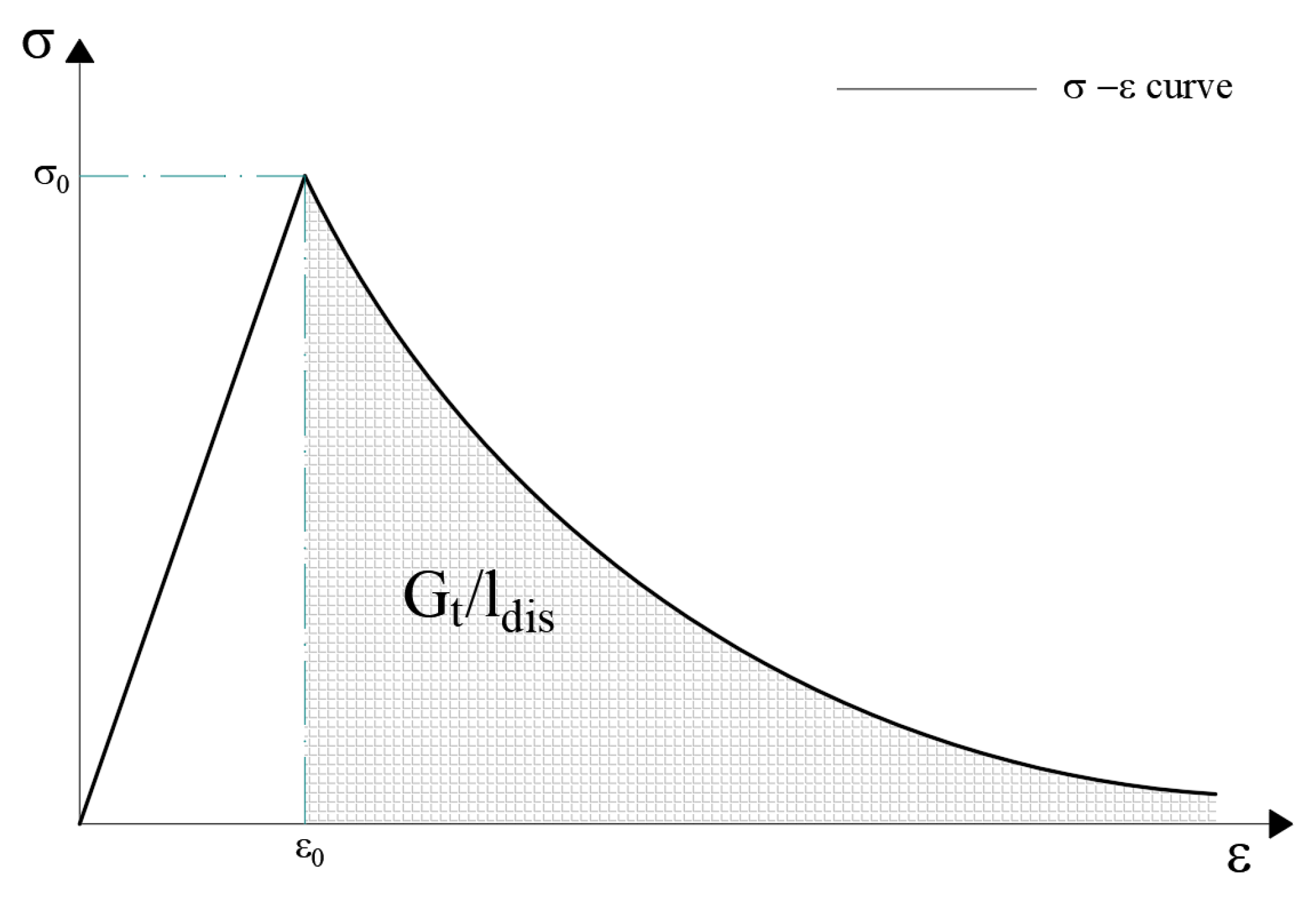

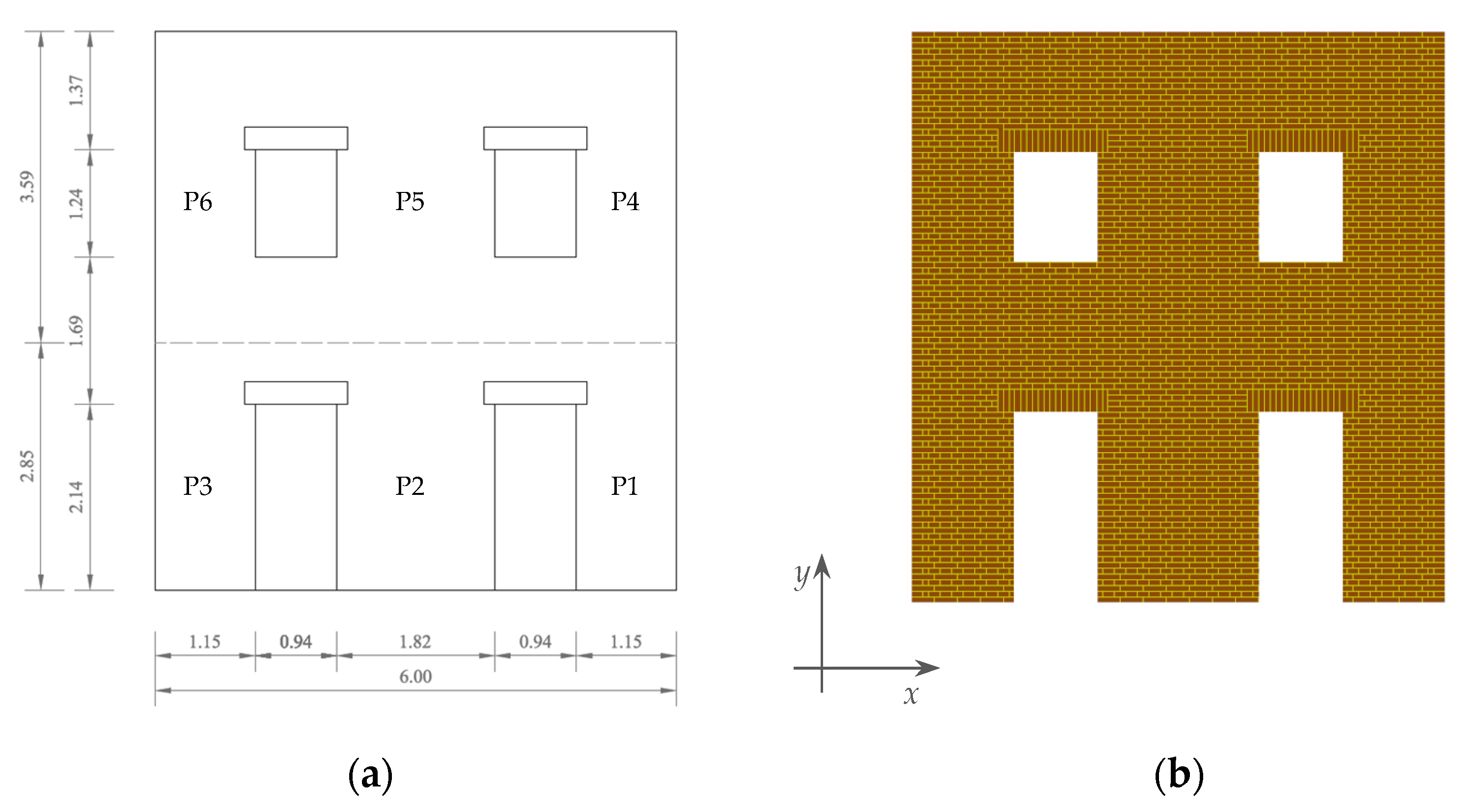
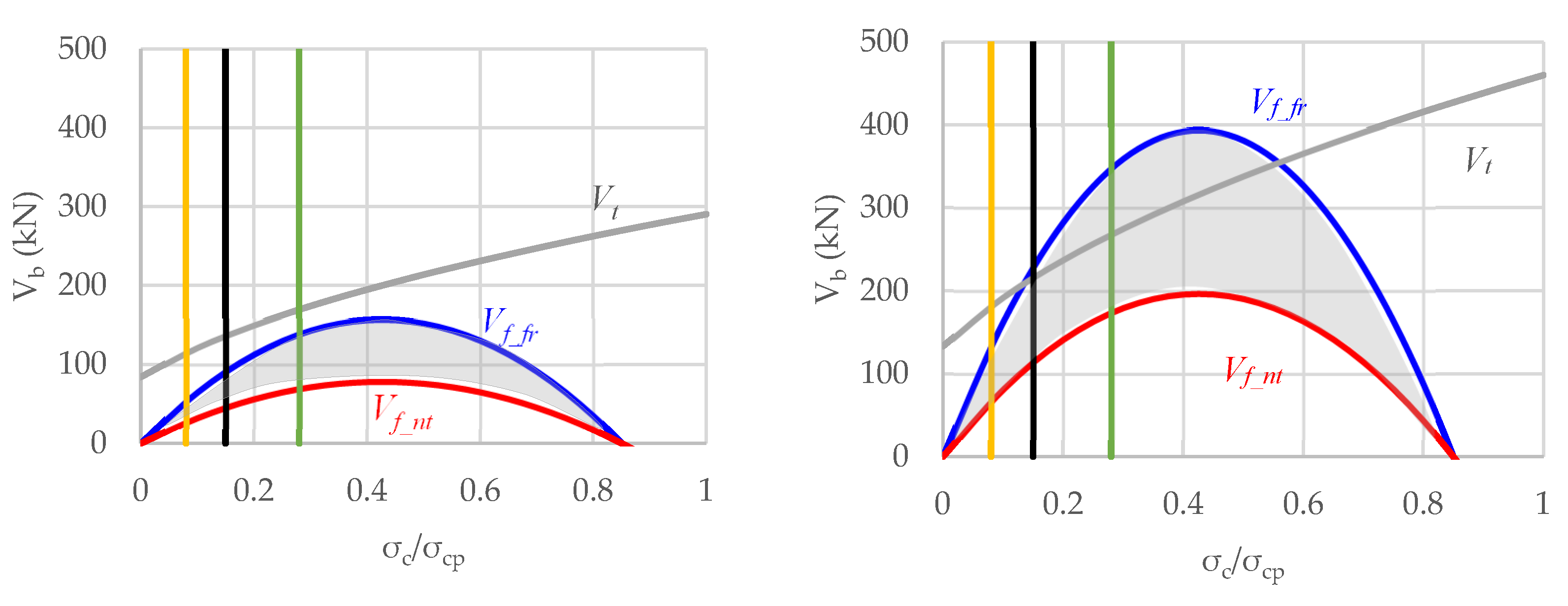
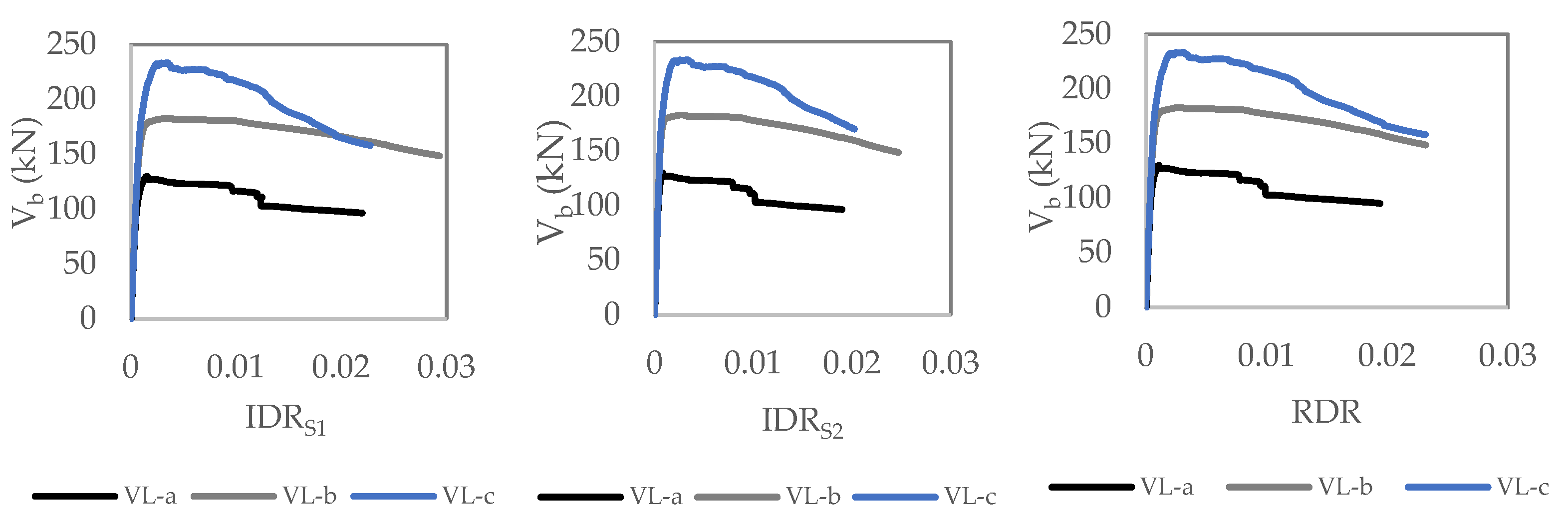


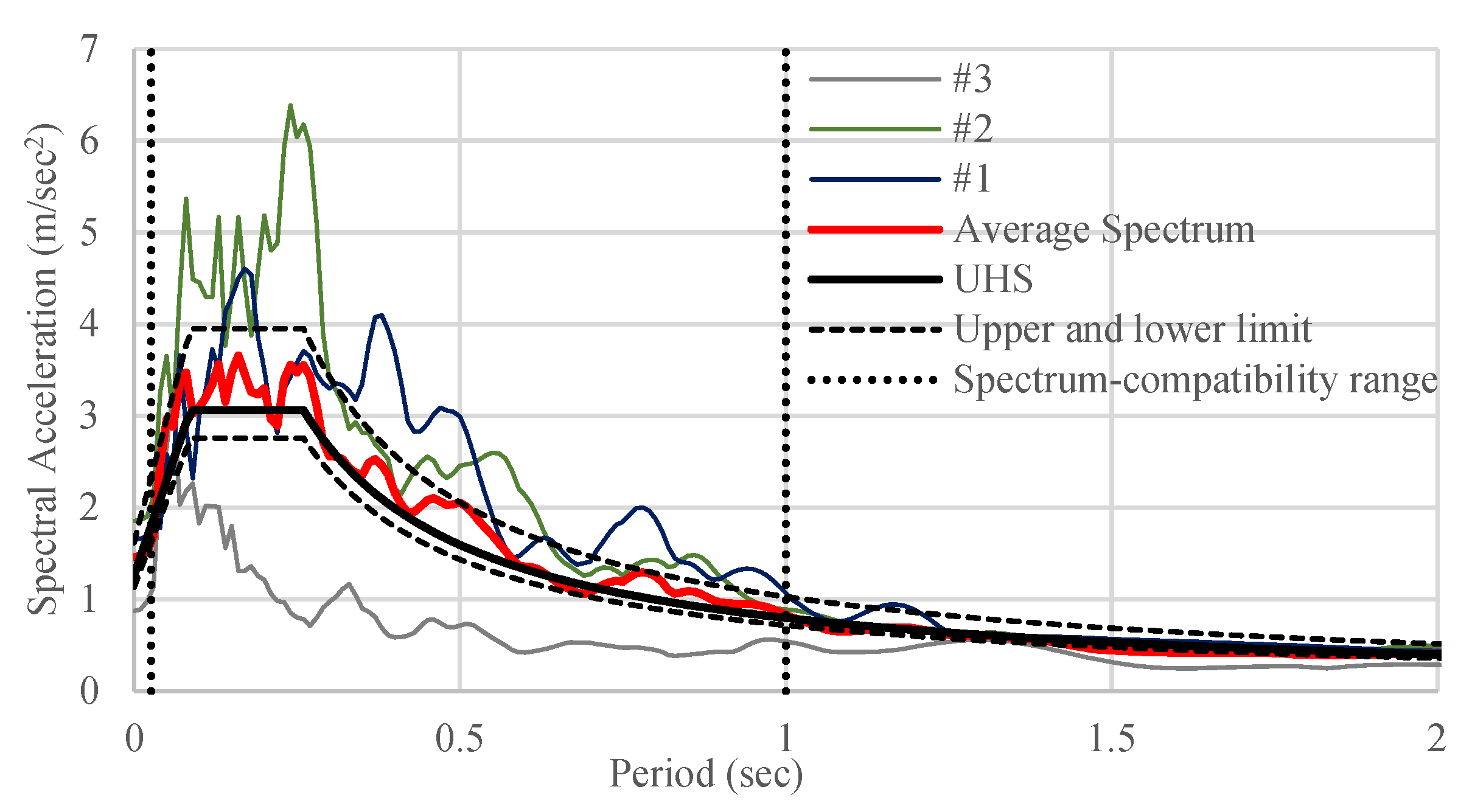

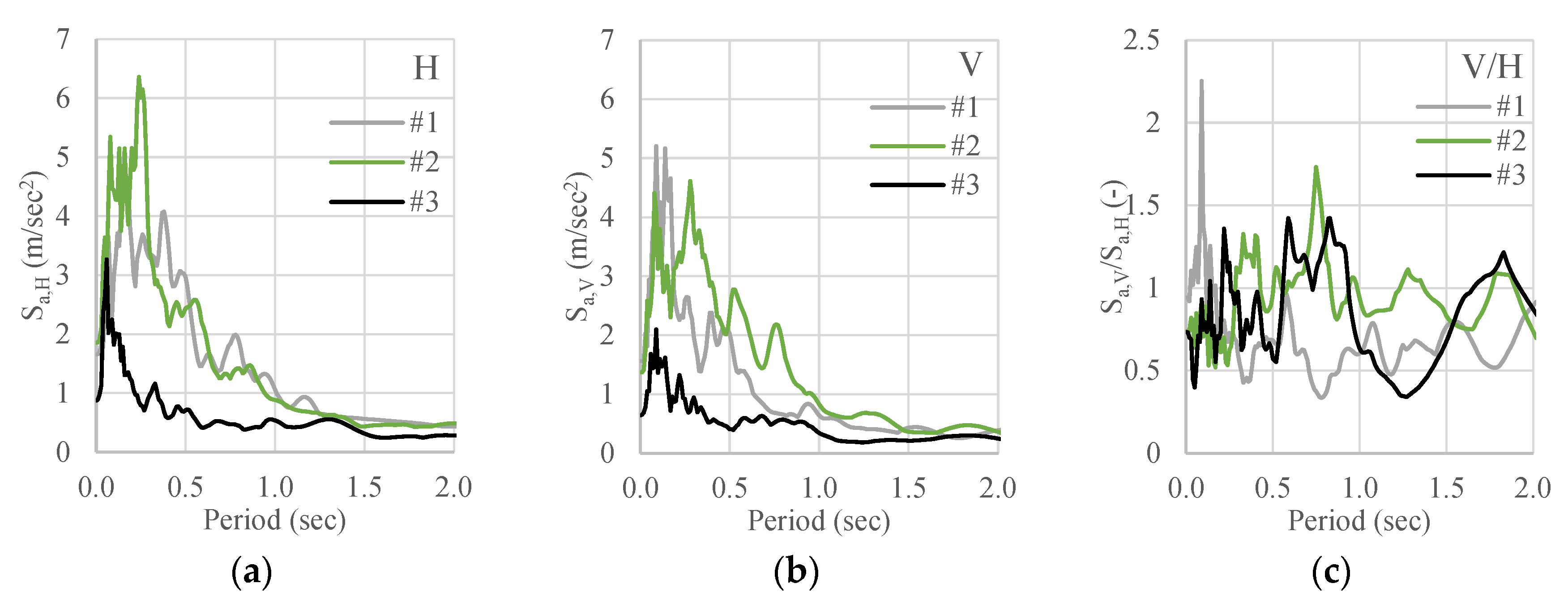
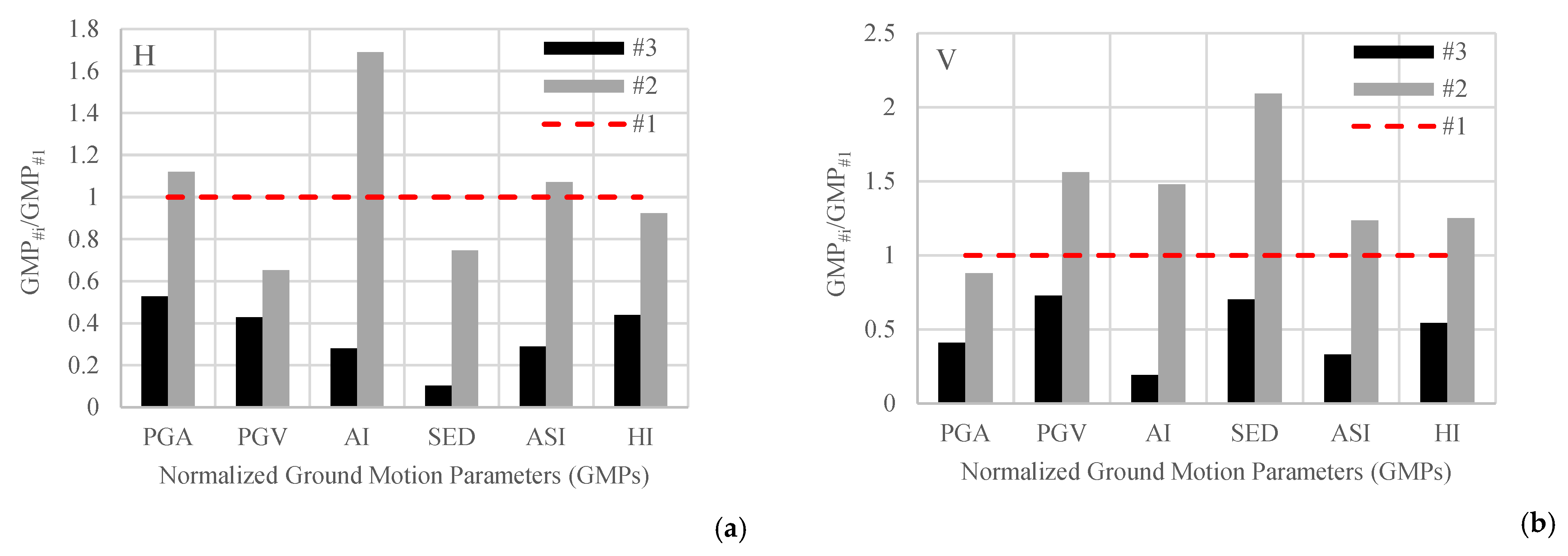
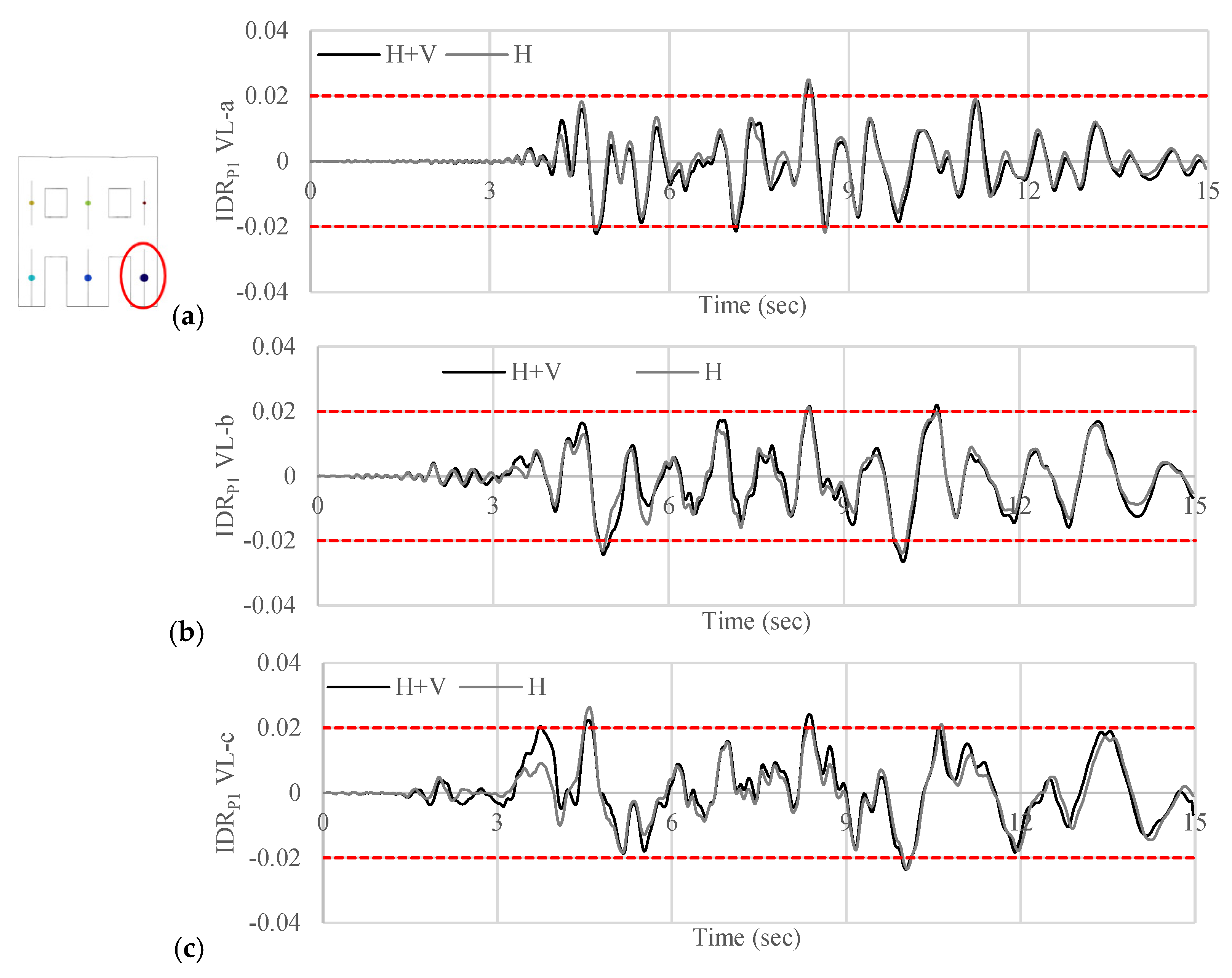
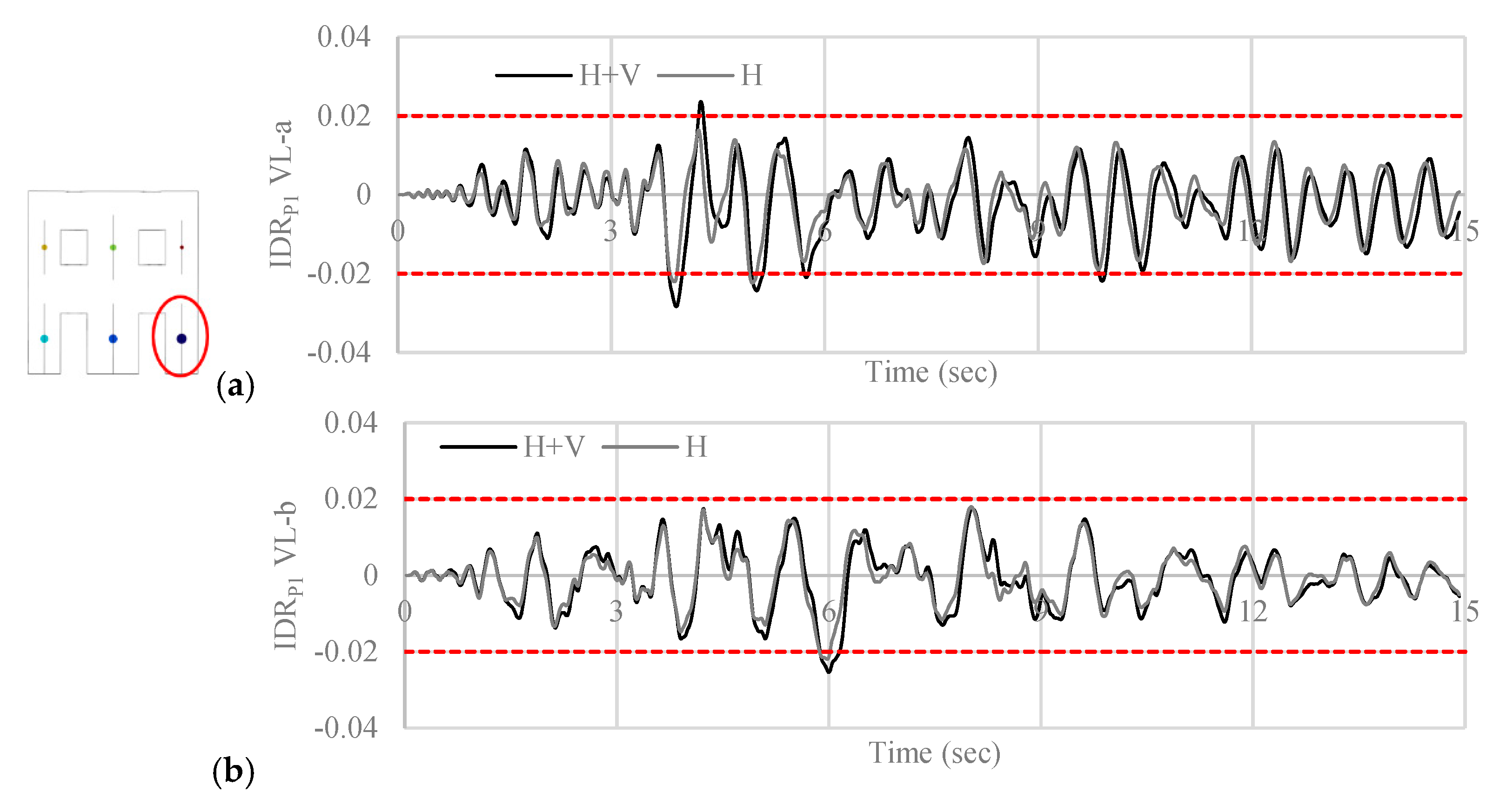

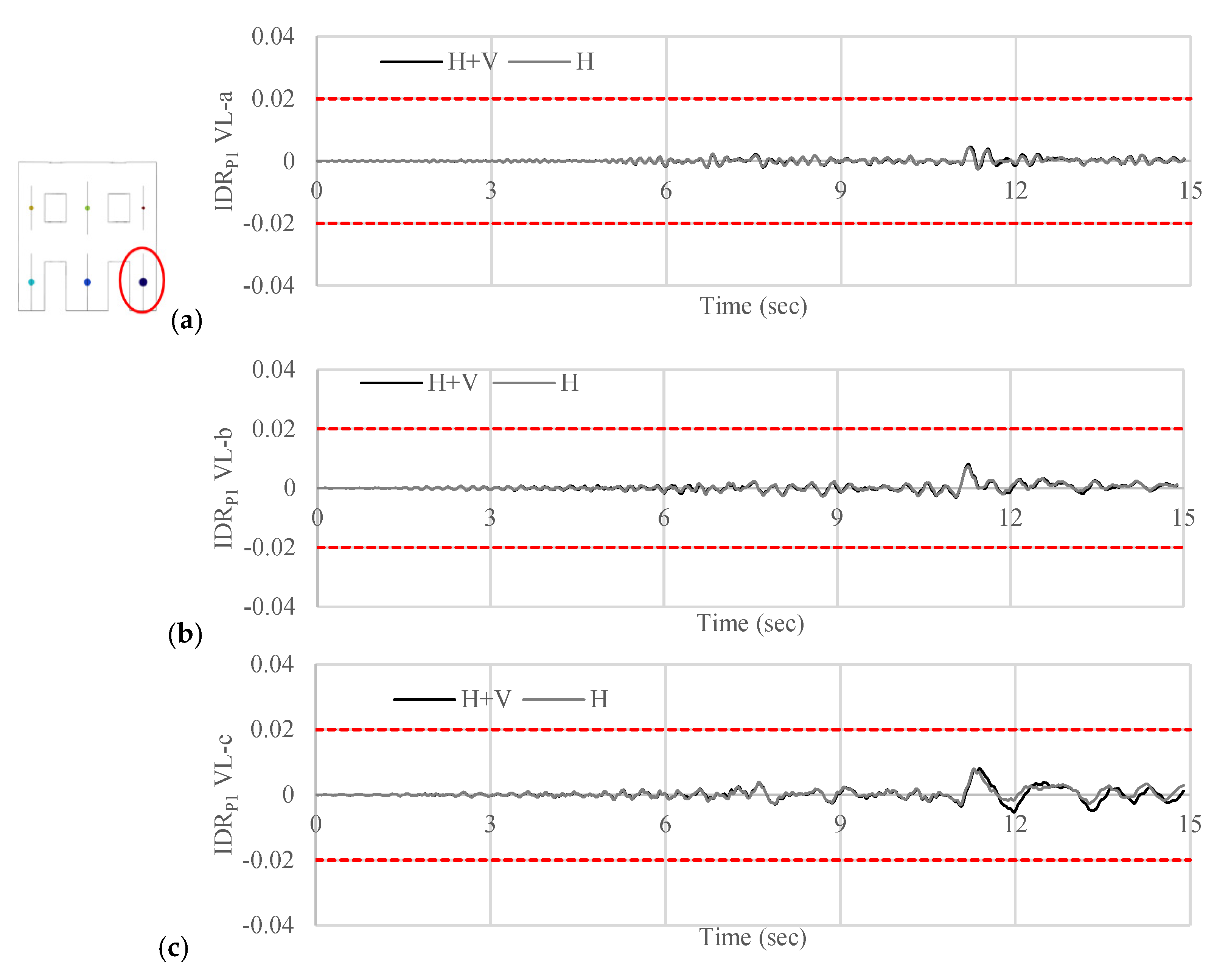
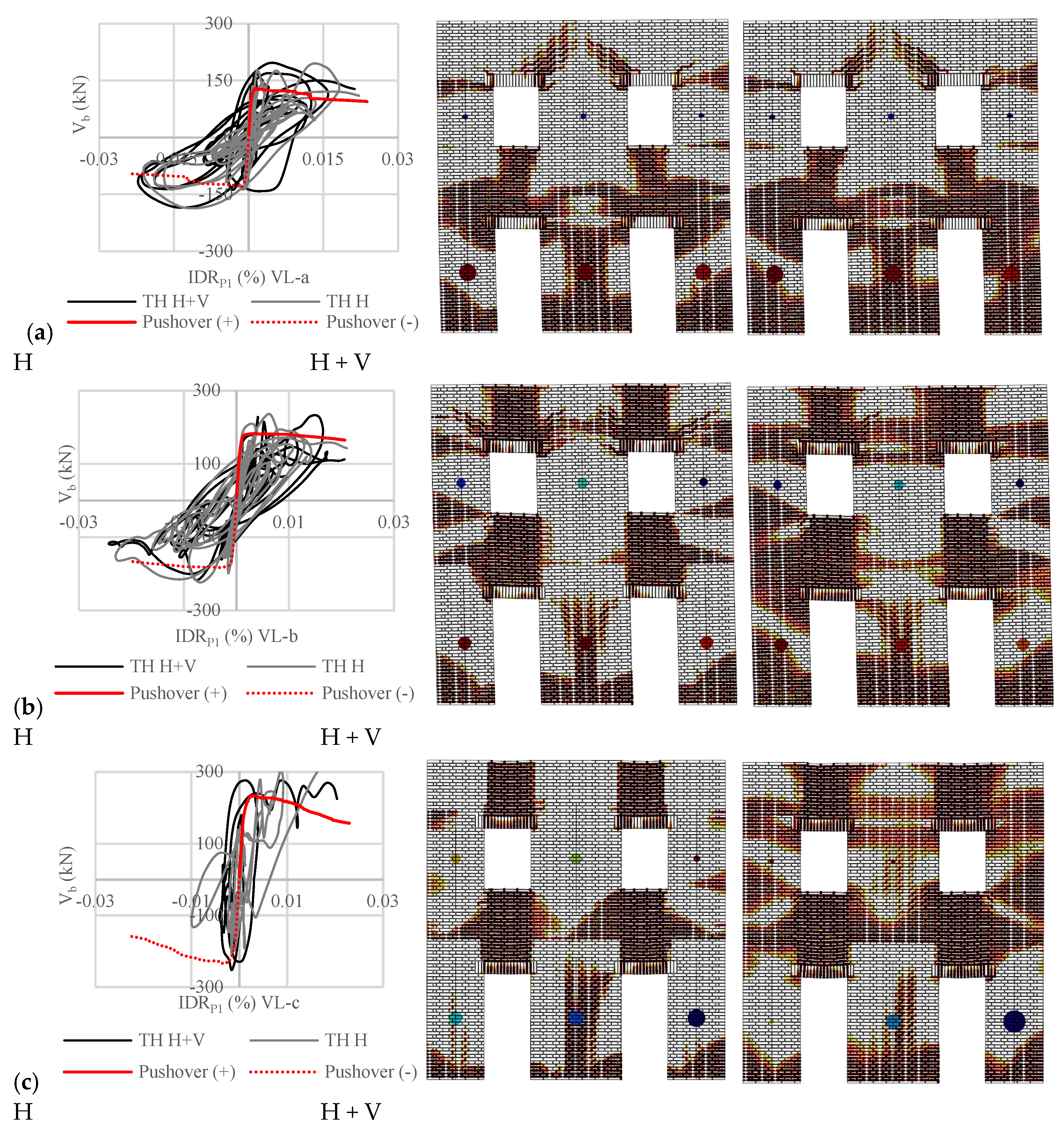
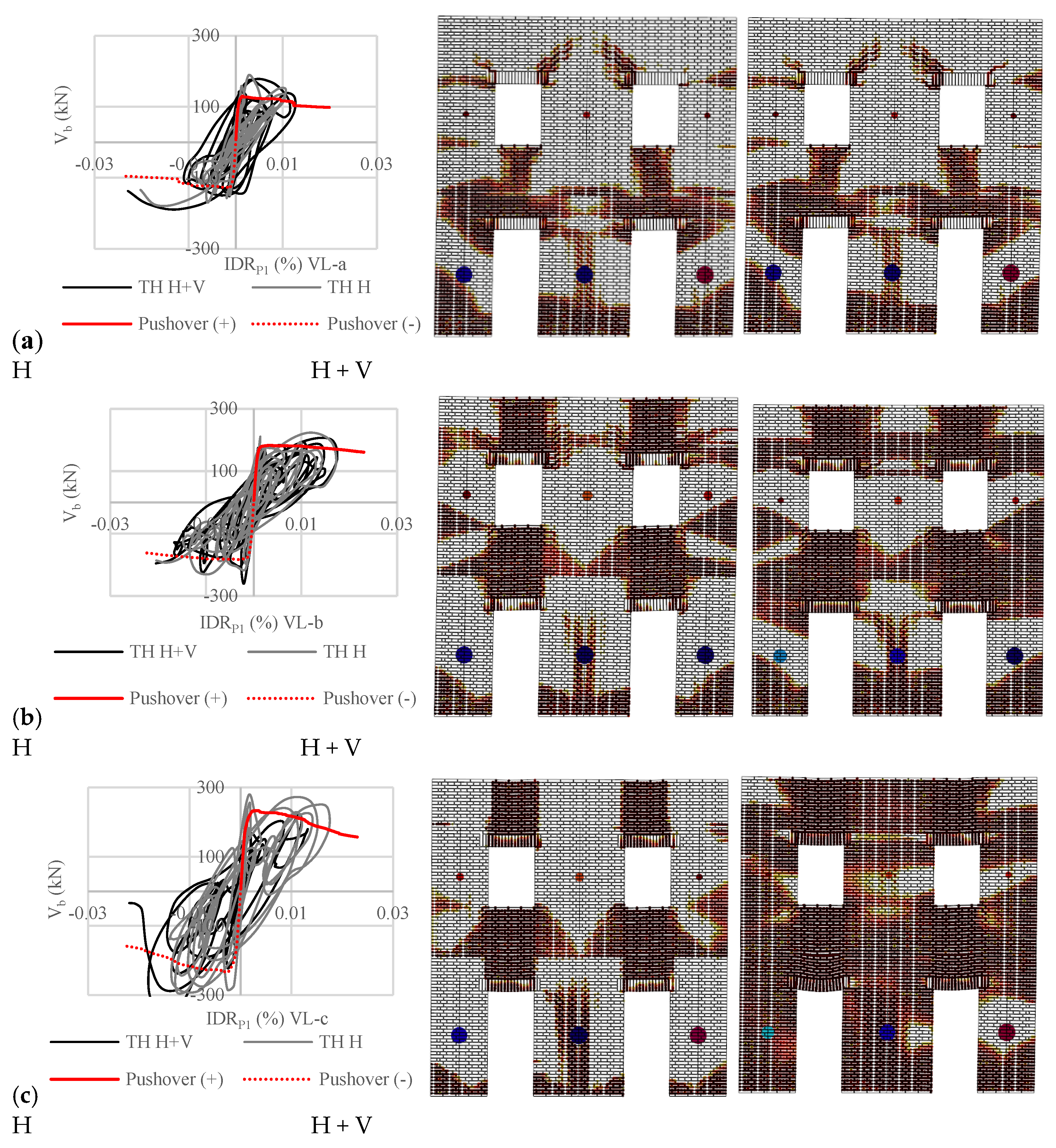
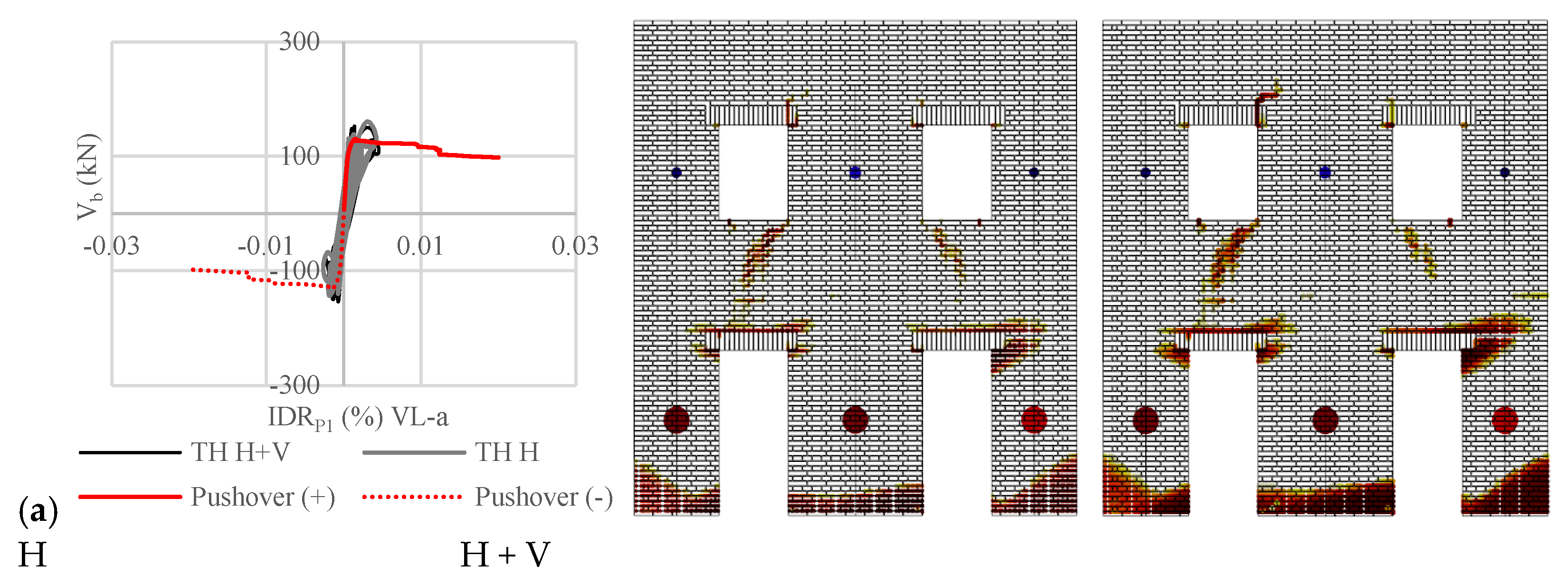
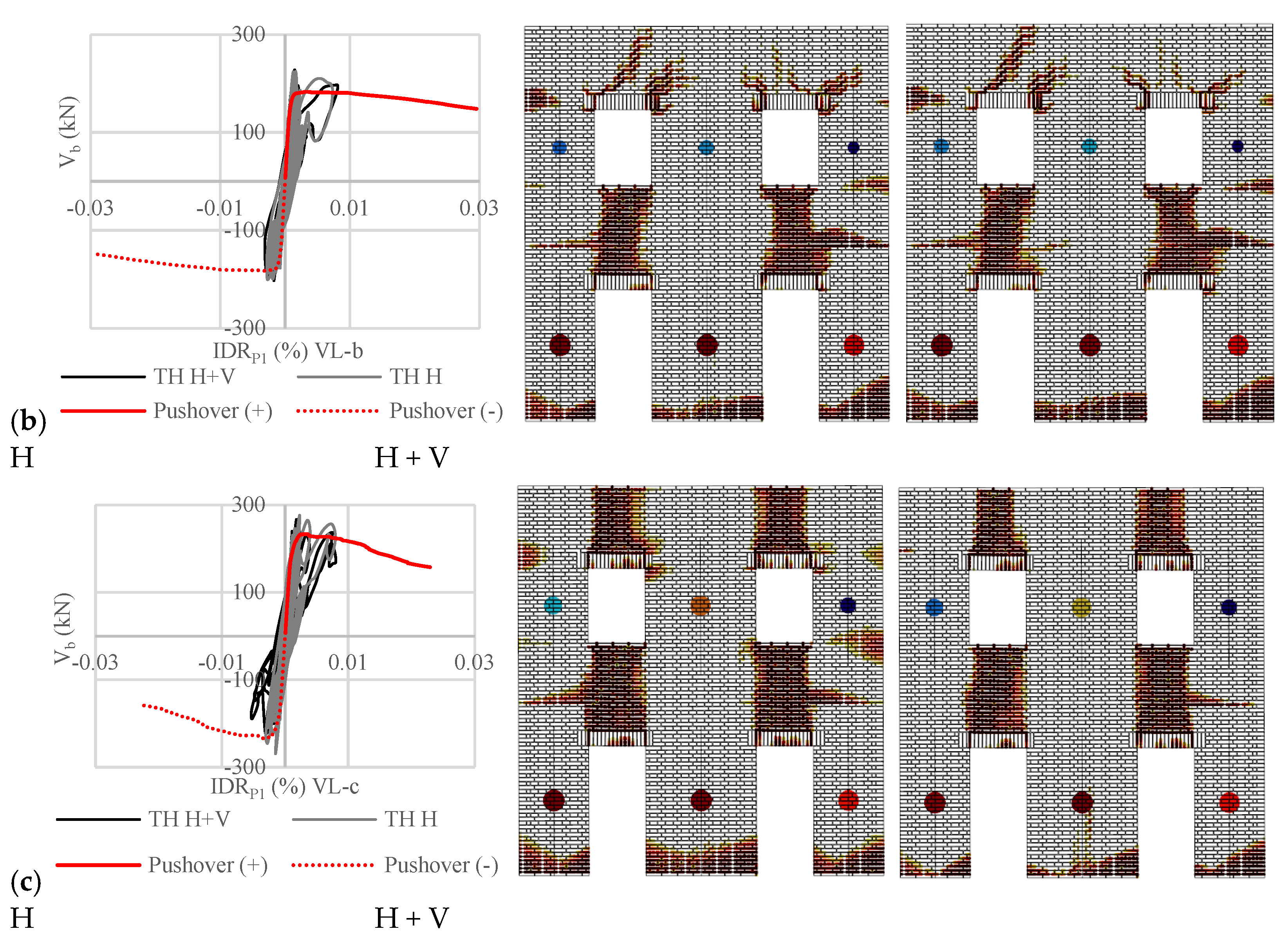
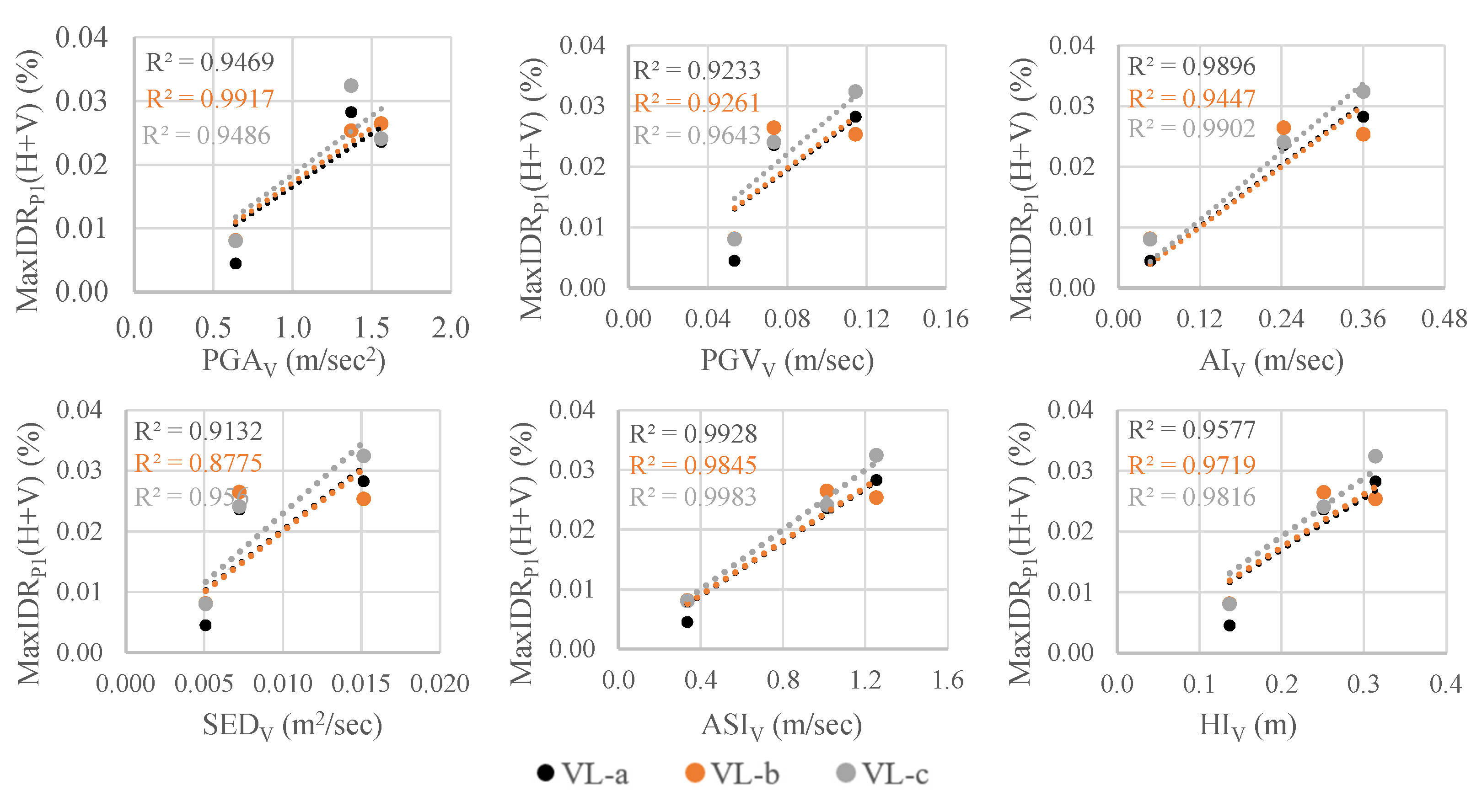
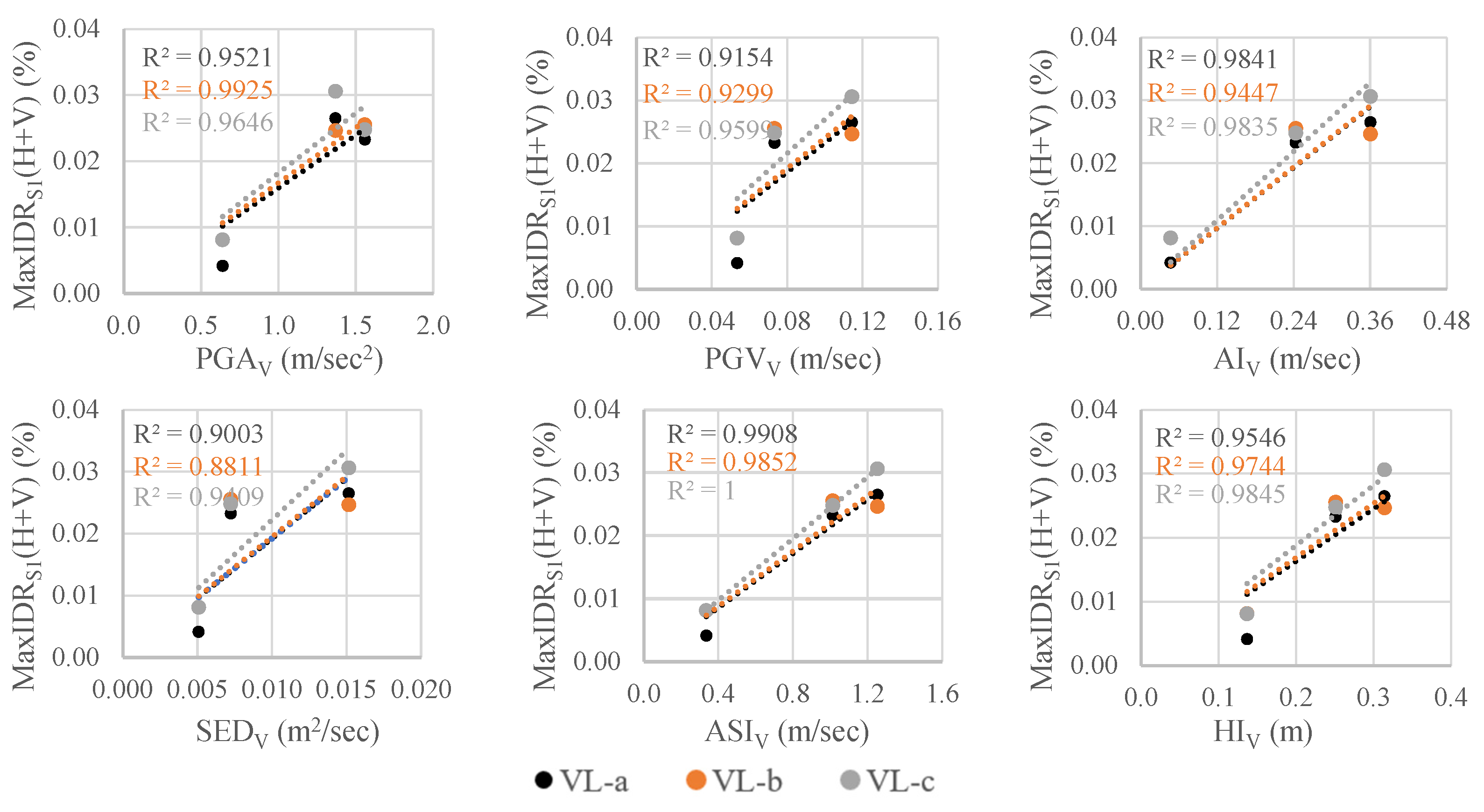

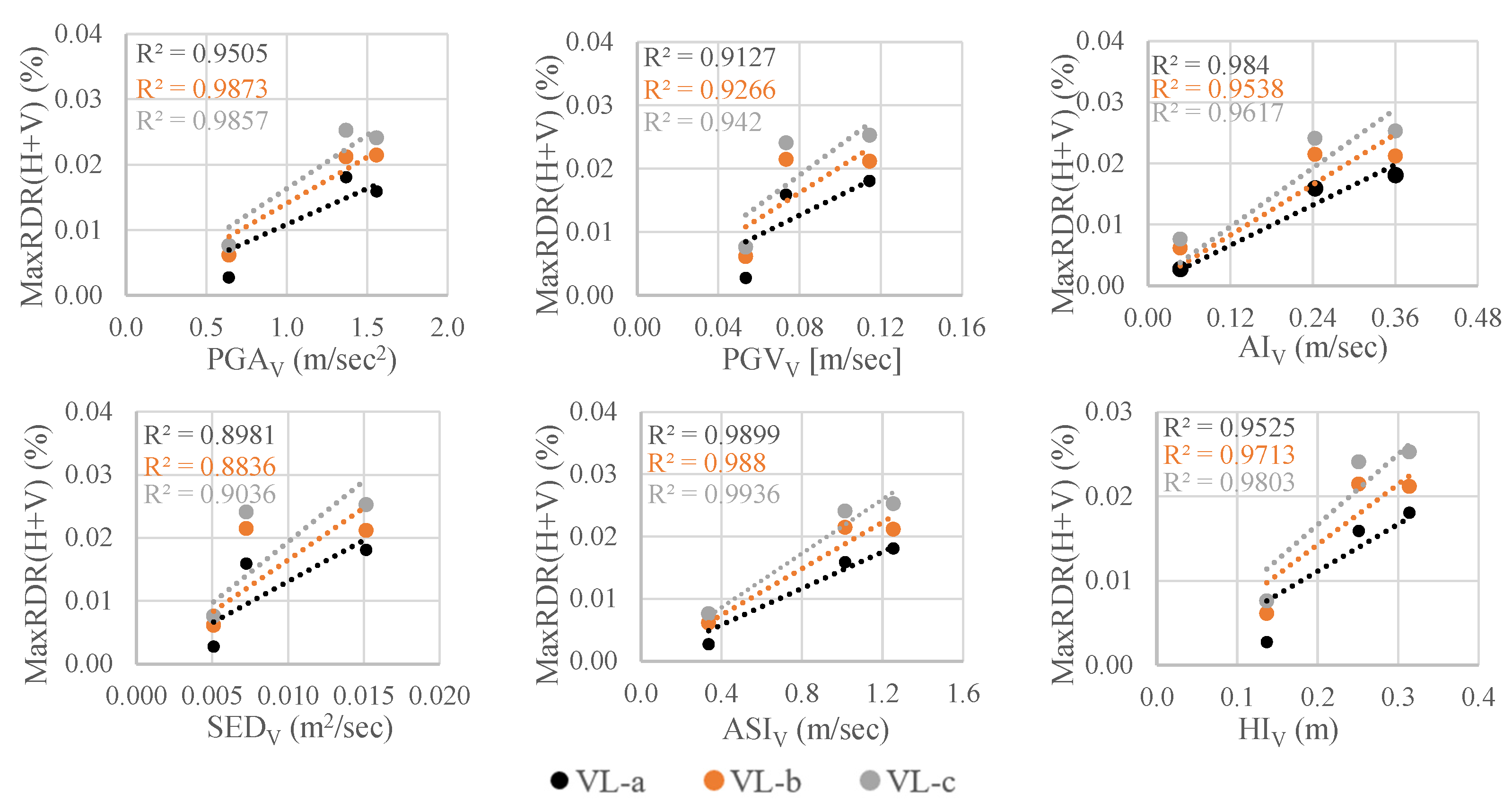
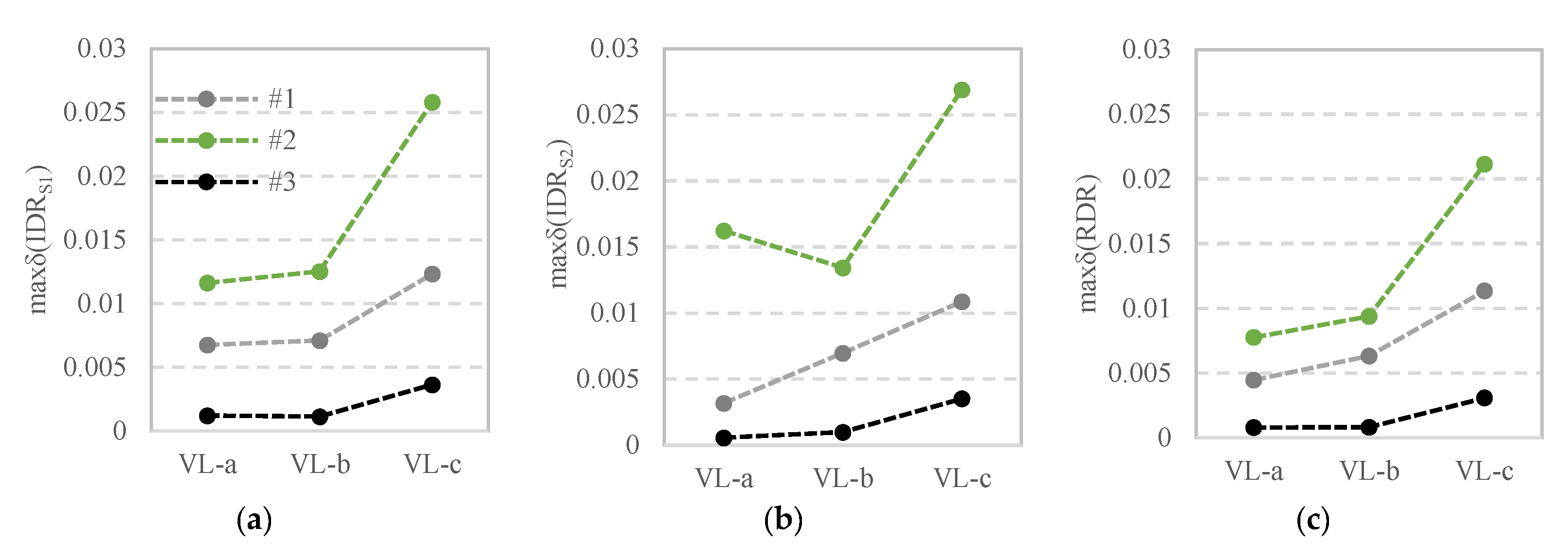
| Parameter | Unit | Value |
|---|---|---|
| Young’s Modulus | E (N/mm2) | 6000 |
| Poisson’s ratio | ν (-) | 0.2 |
| Tensile strength | ft (N/mm2) | 1.5 |
| Tensile fracture energy | Gt (N/mm) | 0.1 |
| Compressive strength hardening | fc0 (N/mm2) | 10 |
| Compressive strength at peak | fcp (N/mm2) | 15 |
| Compressive strength residual | fcr (N/mm2) | 5 |
| Compressive deformation at peak | εp (-) | 0.01 |
| Compressive fracture energy | Gc (N/mm) | 10 |
| Property | Symbol and Units | Value |
|---|---|---|
| Young’s Modulus | E (N/mm2) | 350 |
| Poisson’s ratio | ν (-) | 0.15 |
| Tensile strength | ft (N/mm2) | 0.09 |
| Tensile fracture energy | Gt (N/mm) | 0.02 |
| Compressive strength hardening | fc0 (N/mm2) | 1.6 |
| Compressive strength at peak | fcp (N/mm2) | 3.2 |
| Compressive strength residual | fcr (N/mm2) | 0.5 |
| Compressive deformation at peak | εp (-) | 0.05 |
| Compressive fracture energy | Gc (N/mm) | 70 |
| VL-a | VL-b | VL-c | ||||||
|---|---|---|---|---|---|---|---|---|
| T (s) | Mx (%) | My (%) | T (sec) | Mx (%) | My (%) | T (sec) | Mx (%) | My (%) |
| 0.1328 | 79.57 | 0.00 | 0.1888 | 81.75 | 0.00 | 0.2576 | 83.07 | 0.00 |
| 0.0494 | 13.33 | 0.00 | 0.0700 | 14.14 | 0.00 | 0.0947 | 14.47 | 0.00 |
| 0.0451 | 0.00 | 87.54 | 0.0634 | 0.00 | 89.93 | 0.0861 | 0.00 | 91.30 |
| # | Event Name | Event Mw | Event Date | Station ID | EC8 Site Class | R (km) | PGAH (g) | PGAV (g) |
|---|---|---|---|---|---|---|---|---|
| 1 | Norcia | 6.5 | 2016/10/30 | CSC | B | 14.900 | 0.169 | 0.159 |
| 2 | Norcia | 6.5 | 2016/10/30 | MMO | A | 19.200 | 0.189 | 0.140 |
| 3 | Norcia | 6.5 | 2016/10/30 | T1215 | A | 20.100 | 0.089 | 0.065 |
| Ground Motion Parameters | #1 | #2 | #3 | |||
|---|---|---|---|---|---|---|
| H | V | H | V | H | V | |
| PGA (m/s2) | 0.872 | 0.640 | 1.653 | 1.558 | 1.853 | 1.369 |
| PGV (m/s) | 0.058 | 0.053 | 0.136 | 0.073 | 0.089 | 0.114 |
| AI (m/s) | 0.086 | 0.047 | 0.308 | 0.243 | 0.521 | 0.360 |
| SED (m2/s) | 0.0026 | 0.0051 | 0.0253 | 0.0072 | 0.0189 | 0.0151 |
| ASI (m/s) | 0.404 | 0.335 | 1.400 | 1.014 | 1.499 | 1.254 |
| HI (m) | 0.166 | 0.137 | 0.378 | 0.251 | 0.350 | 0.314 |
| EDPs | Load Case | Record #1 | Record #2 | Record #3 | ||||||
|---|---|---|---|---|---|---|---|---|---|---|
| H | H+V | (H+V)/H | H | H+V | (H+V)/H | H | H+V | (H+V)/H | ||
| IDRP1 | VL-a | 0.02484 | 0.02361 | 0.950 | 0.02229 | 0.02827 | 1.268 | 0.00419 | 0.00451 | 1.077 |
| VL-b | 0.02382 | 0.02647 | 1.111 | 0.02195 | 0.02536 | 1.155 | 0.00733 | 0.00812 | 1.108 | |
| VL-c | 0.02635 | 0.02409 | 0.914 | 0.02404 | 0.03242 | 1.349 | 0.00797 | 0.00804 | 1.009 | |
| IDRS1 | VL-a | 0.02450 | 0.02329 | 0.951 | 0.02090 | 0.02652 | 1.269 | 0.00390 | 0.00419 | 1.072 |
| VL-b | 0.02354 | 0.02554 | 1.085 | 0.02182 | 0.02466 | 1.130 | 0.00739 | 0.00813 | 1.100 | |
| VL-c | 0.02664 | 0.02480 | 0.931 | 0.02388 | 0.03060 | 1.282 | 0.00807 | 0.00813 | 1.007 | |
| IDRS2 | VL-a | 0.01018 | 0.01082 | 1.063 | 0.01017 | 0.01276 | 1.254 | 0.00178 | 0.00170 | 0.956 |
| VL-b | 0.01989 | 0.02149 | 1.081 | 0.01950 | 0.02190 | 1.123 | 0.00535 | 0.00536 | 1.002 | |
| VL-c | 0.02340 | 0.02900 | 1.239 | 0.02073 | 0.02708 | 1.306 | 0.00706 | 0.00767 | 1.086 | |
| RDR | VL-a | 0.01621 | 0.01590 | 0.981 | 0.01491 | 0.01807 | 1.212 | 0.00262 | 0.00273 | 1.043 |
| VL-b | 0.01990 | 0.02147 | 1.079 | 0.01909 | 0.02119 | 1.110 | 0.00578 | 0.00614 | 1.063 | |
| VL-c | 0.02398 | 0.02410 | 1.005 | 0.02137 | 0.02527 | 1.183 | 0.00736 | 0.00762 | 1.034 | |
| maxδ | Record #1 | Record #2 | Record #3 | ||||||
|---|---|---|---|---|---|---|---|---|---|
| VL-a | VL-b | VL-c | VL-a | VL-b | VL-c | VL-a | VL-b | VL-c | |
| Maxδ (IDRS1) | 0.00676 | 0.00710 | 0.01234 | 0.01163 | 0.01254 | 0.02582 | 0.00121 | 0.00114 | 0.00364 |
| Maxδ (IDRS2) | 0.00319 | 0.00698 | 0.01087 | 0.01623 | 0.01344 | 0.02690 | 0.00057 | 0.00099 | 0.00352 |
| Maxδ (RDR) | 0.00447 | 0.00632 | 0.01136 | 0.00777 | 0.00939 | 0.02115 | 0.00080 | 0.00081 | 0.00308 |
Disclaimer/Publisher’s Note: The statements, opinions and data contained in all publications are solely those of the individual author(s) and contributor(s) and not of MDPI and/or the editor(s). MDPI and/or the editor(s) disclaim responsibility for any injury to people or property resulting from any ideas, methods, instructions or products referred to in the content. |
© 2023 by the authors. Licensee MDPI, Basel, Switzerland. This article is an open access article distributed under the terms and conditions of the Creative Commons Attribution (CC BY) license (https://creativecommons.org/licenses/by/4.0/).
Share and Cite
Camata, G.; Di Primio, A.; Sepe, V.; Cantagallo, C. The Effect of the Vertical Component of the Earthquake on a Regular Masonry Wall. Appl. Sci. 2023, 13, 2459. https://doi.org/10.3390/app13042459
Camata G, Di Primio A, Sepe V, Cantagallo C. The Effect of the Vertical Component of the Earthquake on a Regular Masonry Wall. Applied Sciences. 2023; 13(4):2459. https://doi.org/10.3390/app13042459
Chicago/Turabian StyleCamata, Guido, Alice Di Primio, Vincenzo Sepe, and Cristina Cantagallo. 2023. "The Effect of the Vertical Component of the Earthquake on a Regular Masonry Wall" Applied Sciences 13, no. 4: 2459. https://doi.org/10.3390/app13042459
APA StyleCamata, G., Di Primio, A., Sepe, V., & Cantagallo, C. (2023). The Effect of the Vertical Component of the Earthquake on a Regular Masonry Wall. Applied Sciences, 13(4), 2459. https://doi.org/10.3390/app13042459






